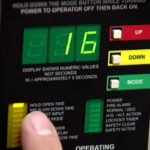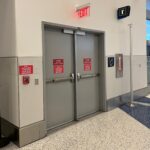I recently came across an app that literally “opens doors” for people who have disabilities that make it difficult or impossible to initiate an automatic door by pushing an actuator. The app is being developed by Portal Entryways (there’s more info here, and you can email the company here).
Check out how it works (and note the excitement of the people testing the app):
The app would be installed in the phones of people who are unable to use the wall-mounted actuator, and as long as the person has the app running in the background on their phone, the doors equipped with special receivers will open automatically when the phone is within about 10 feet of the door. The door will stay open until the user has moved out of proximity of the door.
The question here is whether an app on a user’s phone qualifies as a “knowing act” (more background on that here). The standard for low-energy operators – BHMA A156.19 – currently defines a knowing act as: “Consciously initiating the powered opening of a low-energy door using acceptable methods including: wall or jamb-mounted contact switches such as push plates; fixed non-contact switches; the action of manual opening (pushing or pulling) a door; and controlled access devices such as keypads, card readers, and keyswitches.”
Could an app with limited distribution be considered a controlled access device? BHMA is planning to address this in the next edition of the standard, so for now there is no definitive answer to that question. It would be up to the code official whether the app can be used, and whether any safety sensors are needed. I spoke to the US Access Board and the International Code Council, and they referred me back to BHMA, since the requirement for a knowing act is only included in the BHMA standard. I didn’t get the impression that any of the people I spoke with were overly concerned about the effect of the app on safety, but that is my unofficial opinion.
This app is an important tool for people who are not able to use a wall-mounted actuator, so I would really like to find a way to allow this type of automatic operation while still maintaining the necessary level of safety. What do you think?
- Is the app acceptable because of the limited number of users who could be trained not to continue to approach the door if they see a person in the path of the door swing?
- Should a safety sensor be added that alerts the user to someone standing in the path of the door so they can wait to approach until the person moves out of the way?
- Is it necessary to have safety sensors interface with the receiver to prevent the door from opening until the area is clear?
- Guide rails are required when an automatic door is opened by a sensor that detects each approaching occupant, but the rails can be difficult or impossible to retrofit on existing openings. Is an acceptable level of safety achievable without the rails considering that the app will only be used by specific people?
WWYD?
You need to login or register to bookmark/favorite this content.







My question why the additional requirements over what is required now?
And why would not the additional requirements be required now, on an automatic door?
Great idea!!!
Hi Charles –
I’m not sure I understand your question. Which additional requirements do you mean?
– Lori
Ok saw the video
Same comments as before,
But on that particular door, is there an app to release the magnetic lock, on the door?
This is Josh from Portal. The maglock on this particular door is not locked during the day so the door opens freely. The app does not interface with the maglock security system
You could argue that she is “Consciously initiating the powered opening”. She certainly understands what she is initiating when she comes within a certain distance of the opening. Perhaps additional signage could be added to cover the liability noting the door can be activated by a “wireless activation device”?
That app is a fantastic product for those that need it! Thanks for sharing
Install a Superscan or LZR microscan on the safety side of the door, that would stop it from opening into someone on the swing side and since the app holds the door open that would be safer than even a knowing act IMO.
Obviously there are other factors but I would consider it a knowing act door still since it’s not a motion sensor activated door.
I will be doing this with a mobile credential. In this sense, it is a part of the larger access control system and no special apps are required. Some access systems also have a separate relay output specifically for this purpose. Simply go to the credential and check the ADA selection. Then using their card (or in this case a mobile credential) will unlock the door and energize the operator. I have also done this with standard prox cards, in one case, actually mounting the prox card to the wheel chair. So the ability to do this has been around for some time.
The only issue that i have always had with this is if the person merely walks past the reader. The way I am doing this now (using Bluetooth LE, along with some very tight directional adjustments) may resolve this minor issue.
Making a prediction here: I think we’ll see the day when card readers are not required any longer. Simpy standing in front of the door in a certain direction will be enough to unlock/open the door.
The questions you have listed at the bottom in Orange.
To me if it meets automatic door requirements, this is just an added feature, and nothing else is required
How about a short time delay with an audible alarm (tone or voice)to alert those who might be in the way?
Hi Liane –
Good idea!
– Lori
In California we require two actuators or 1, 36″ actuator. Wouldn’t the person be able to open the door by these means? Steering the chair into the actuator would activate the door (if installed to code)?
Seems a max tx distance should be allowed or possibly even a time delay would be more preferable, similar to currently permitted hold-open times for other door closers. Holding the door open indefinitely while the user app is proximal to the door would be a concern both for energy conservation reasons as well as relates to fire rated doors. One quick example: many court houses now have cell phone lockers proximal to the entrance and before security. Cell phones are not permitted anywhere else in the building. If someone forgets to close the app when they place it in the locker the door could remain open until that person concludes their business with the court.
That’s an interesting point Larry! I’ll check with the app developers and see how the hold-open works.
– Lori